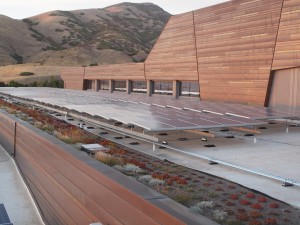
Ennead’s new Natural History Museum at the University of Utah is framed by the mountains and boasts solar panels, green roofs and breathtaking design.
So, I bet most people would not typically put Charleston and Salt Lake City in the same sentence. But I find myself doing that more and more since I happened to visit both earlier this month. And specifically comparing what great walkable cities they are. Charleston has always been that while Salt Lake City has become that, at least it has in my mind in the past five years.
Autumn is the busy conference season. I spent three days in Charleston for the APT conference followed by three days in Salt Lake City for the AASLH conference. While conference activities and speaking engagements kept me very busy, I did carve out some time to walk around. I’ve been to Charleston at least ten times and Salt Lake probably five times so I know the cities fairly well. One of the surprising things I think is that while Charleston is based on a colonial plan of narrow streets and low density, Salt Lake City was laid out as part of the great western movement, with very wide streets to allow carts and horses to turn around in the street. So how can narrow streets and wide streets both encourage walkability?
Salt Lake City’s New Walkability

The retractable roof in Salt Lake CIty’s new downtown mall, City Creek Center. This indoor/outdoor shopping center connects the Library to the Convention Center and helps make downtown Salt Lake whole again.
Now, the wide streets and long blocks of Salt Lake are still not as easy to navigate as Charleston’s intimate ones, but what has happened in the past four years since my last visit is that many vacant or underutilized buildings in the downtown core have been reused, vacant lots and holes in the urban fabric have been beautifully infilled, the light rail is being used and the streets are vibrant with pedestrians. A new indoor/outdoor mall, City Creek Center, just opened, tying the convention center area with the rest of downtown. The convention center is no longer a vast, eerie presence on the edge of downtown. While I’m not a huge fan of malls, this one rises above the rest. It’s anchored by my favorite department store, Nordstrom’s, and wraps around a natural creek that runs through the site. It also has the first retractable glass ceiling I’ve seen on a mall. The day I was there it was open and it was glorious. The grid also makes it easy to figure out where you are and how to walk from one end of downtown (Moshe Safdie’s Library and the City & County Building) to the other end (the Convention Center). And the light rail takes you up to the University of Utah with its amazing new Natural History Museum by Ennead (formerly known as Polshek & Partners). The Museum is one of the best new buildings or museums I’ve been to in quite a while.
Remaking urban cores
Both Charleston and Salt Lake City show us how diverse and wonderful our country is and how each city, despite their differences, is purely an American city. I used to think Salt Lake City was a sleepy western town. All the new planning and construction has decidedly changed my thinking. It’s a delight to walk around; there are terrific restaurants, shops and hotels on every block; the Temple and the restored State Capitol make it unique and the Library and Natural History Museum have brought green starchitecture (GREAT “starchitecture” by the way) to Utah. If you have a chance, visit Salt Lake City – it’s the perfect place to enjoy a great, vibrant and historic downtown and then head off for some hiking or biking in some of the best national parks in the world!
For more photos please feel free to view my Natural History Museum photo album and Utah State Capitol photo album on my Facebook page.
And if you’d like to “subscribe” or follow my blog, True Green Cities, please sign up through the “Subscribe” button at the bottom left of this page. You’ll receive a daily recap when new blogs are posted.
